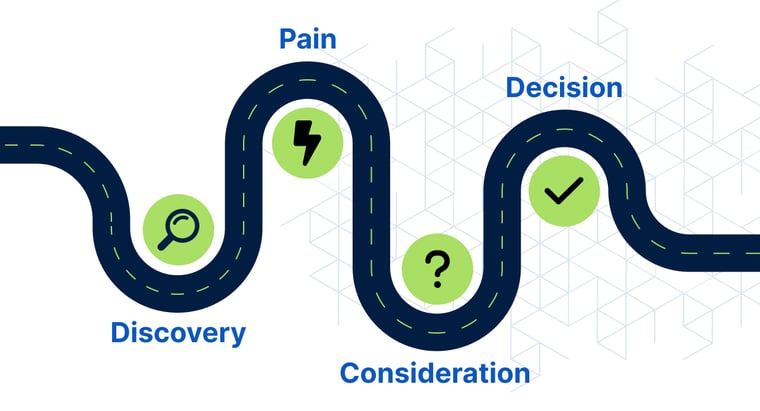Modern Buyer Behavior: How to Adapt Your Sales Approach
I’ve been in sales for over 15 years across the engineering, telecommunications, banking, and software development industries. In that time, I’ve closed seven-figure deals and helped grow companies’ revenues 10 times over. My success can be attributed to many things, but today, one of the most important contributors is maintaining a keen awareness of evolving buyer behavior.
Knowing how buyers behave enables us, as sales professionals, to adapt our sales approach and ensure we’re able to disrupt preconceived notions they have about solutions in the market, instill authority, and properly guide them in their buyer journey.
Understanding Modern Buyer Behavior
If you’re leading a sales team, no doubt you’ve seen depictions of the traditional sales cycle countless times. However, the cycle has shifted significantly in recent years. To understand where we are now, let’s first quickly review the traditional cycle:

- Discovery—First, the buyer is focused on identifying the goals, KPIs, and outcomes they’re trying to achieve.
- Pain—Next is identifying problems areas—the barriers that are preventing the buyer from achieving their desired outcomes.
- Consideration—Armed with knowledge of their barriers to success, now the buyer is searching the market for vendors who can solve their problems.
- Decision—Finally, the buyer reviews and shortlists vendors who most closely match what they’re looking for in a solution.
Walking together along this path is ideal because it works in favor of both sellers and buyers. Sellers learn the buyer and help them find the right solution. Buyers get a more informed external perspective, since sellers have often worked with numerous buyers facing the same or similar challenges.
Check out the full webinar on this topic, which includes additional insights. It features myself and Ron D’Andrea, COO of Global Performance Group.
However, modern buyer behavior has made that initial sales handholding and consultation virtually obsolete.
Buyers are no longer looking to us for consultation. In fact, they don’t want to hear anything from us until after they’ve done their own research and are heavy into the consideration phase of their journey.
This is supported by a McKinsey report, which indicates that over 70% of B2B buyers prefer digital self-service and remote experiences when identifying and evaluating new suppliers—with 22% of buyers preferring to make their buying decisions in a completely self-service environment.
This means that nearly a quarter of your potential buyers will typically evaluate your offering—and even make a purchasing decision—without ever speaking to your sales team.
Why the change in buyer behavior?
It comes down to a few factors, including greater access to technology and digital information, along with shifting demographics. According to a Pew Research Center analysis, Millennials became the largest generation in the American labor force in 2016—more than one-third (35%) to be exact.
Millennials are known to be more in touch with technology than previous generations and more prone to asking Google questions before asking an actual person.
So it’s no surprise that today’s buyers are showing up to our virtual doorstep with a strong opinion formed of what solution they’d like to move forward with. Our job as sellers then becomes relegated to simply talking about features and negotiating price.
This new buyer behavior has two negative outcomes.
Firstly, it shortchanges sellers from their primary role in learning the buyer and helping them find the right solution.
Secondly, it also does the buyer a disservice because they have formed their opinion based on limited knowledge, confirmation bias, and assumptions about the availability and fit of potential solutions—which means they may not be purchasing the best solution for their needs.
How To Adapt Your Team’s Sales Approach To Address Self-Service Buyer Behavior
So how do we marry the above reality of evolving buyer behavior with our roles as sales professionals? To avoid simply meeting buyers at the consideration stage and becoming an order taker, keep reading for actionable steps your sales team can follow to operate more effectively and better engage buyers.
1. Surface buyer needs.
Help buyers understand what they actually need, not just what they want. That means directing your sales team to take a step back when a buyer suddenly comes to them asking for pricing. While pricing is typically a buying signal and the sales instinct is to run the numbers to capture the sale ASAP, don’t let them just start throwing out quotes based on the solution the buyer is asking about.
The buyer is confirming or challenging a decision they’ve likely already made. But we have to ignore our instincts and, instead, challenge the buyer’s assumptions.
My go-to tactic for when buyers ask for pricing without any previous interactions is to actually pose a question back to them. For example:
Buyer: “How much will it cost to implement X solution?”
Salesperson: “It depends. What are you trying to accomplish?”
The beauty of this question is it reframes the conversation and takes us back to the discovery phase of the buyer journey—the one the buyer inadvertently removed your sales team from in taking the self-service route.
Encourage your team to get buyers to walk them through what they’re trying to achieve. This presents the opportunity to have the buyer explain what success looks like to them and the pain points preventing them from achieving that success. This knowledge, in turn, allows your sales team to pinpoint exactly how your solution alleviates the buyer’s pain points instead of just giving a broad description of features that may or may not apply to their situation.
Not only does this approach give your sales team the chance to talk about the solution the buyer needs in the right context, but it also allows the buyer to properly differentiate your solution from others they’re considering.
2. Challenge buyer assumptions.
In the webinar linked above, D’Andrea notes that taking the buyer back to the first stage of their journey is challenging. They believe they’ve already done what’s needed to arrive at the most appropriate destination.
To combat potential opposition in going backwards in their journey, D’Andrea provides several “striker” questions your sales team can ask buyers that they may not know the answers to—questions the buyer must think about and that make them reevaluate whether they’re at the right destination. These thinking questions add value to their experience and get them in the right frame of mind for discovery:
- Validate. Ask the buyer to articulate or quantify what they’re trying to achieve and why. If your sales team is on the right track, they’ll likely hear questions from the buyer such as, “I never thought of it that way,” “No one ever asked me that,” or “That’s something I hadn’t considered.”
- Challenge. Provide a reality check by confronting the buyer with data or benchmarks, preferably from a third party. Your sales team could also challenge the buyer with research they’ve done on their company vs. the industry, such as questioning why their revenue grew at a much lower rate (e.g., 5%) than the industry average (e.g., 12%).
- Compare. Analyze the resulting hierarchy of values by comparing X to Y. For example: How does this product launch compare to the last product launch? What challenges are you facing this year vs. last year?
- Rank. Identify, prioritize, and organize the buyer’s wish list. For example, if the buyer has shared key outcomes they want to see from implementing their chosen solution, have your team ask the buyer to identify and rank the three most important outcomes in priority order. Then your team can follow up asking why those outcomes are critical and why the buyer gave each outcome that ranking.
- Shock. Explore the worst-case scenario by asking questions about possible outcomes. We want the buyer to understand the consequence of making the wrong decision—in choosing the wrong provider. People often make decisions to avoid risk, and highlighting that risk can showcase your team’s awareness of outcomes the buyer may not have considered.
- Futurize. Fast forward to the ideal result, and have the buyer describe the effects. Have them describe the best-case scenario.
3. Give them the self-service option they’re looking for.
Once your sales team has engaged with the buyer and gained important context surrounding their needs, it’s back to the consideration stage. Except now your team is armed with knowledge to deliver a proposal that addresses all the buyer’s specific concerns instead of a generic one.
But remember that these buyers are still inclined toward self-service—even if your team provides value and builds rapport, the buyer will only allow hand-holding for so long.
That’s where sales proposal platform Talewind enters the picture. It’s designed to personalize, automate, and improve the experience your buyers have when evaluating your proposed solution. With Talewind, you can create a stunning digital showroom that offers the entire buying team a one-stop shop to get answers to their sales questions and learn more about your business.
Your digital showroom—which you can customize with the buyer’s logo, font, and other branding elements—can include whatever resources are most relevant, including sales presentations, case studies, work samples, quotes, etc. The combination of these aspects enhances the prospect’s experience, showcases how much you value their business, and increases the likelihood of closing the sale.
Self-service buyer behavior is likely here to stay, so the sooner you implement the above adjustments to the typical sales approach, the better chance you’ll have at closing deals.



